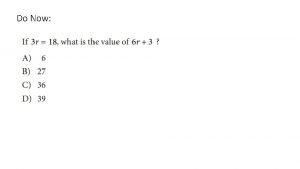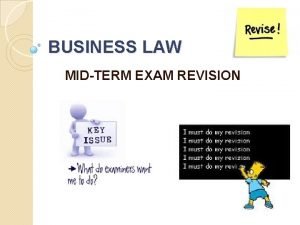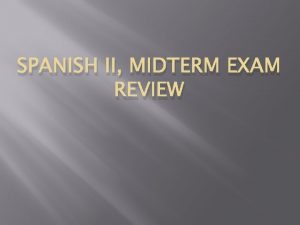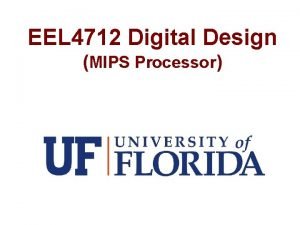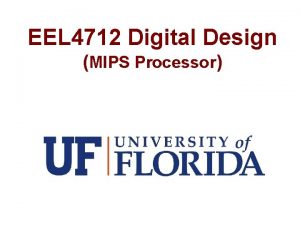EEL 4712 Digital Design Midterm 3 review CDC














- Slides: 14

EEL 4712 Digital Design (Midterm 3 review)

CDC l When the behavior of a circuit demonstrates some amount of randomness, it is likely that the output of a FF is: u metastable l When synchronizing a single bit across clock domains, what type of synchronizer should you use? u Dual flop l In what situation can a dual-flop synchronizer be used for multiple bits? u When the input is guaranteed to change by only 1 bit at a time (e. g. , gray coding). 2

CDC l When synchronizing multiple bits across clock domains and don’t care about throughput, what type of synchronizer should you use? u Handshake or mux recirculation l When synchronizing multiple bits across clock domains and throughput is important, what type of synchronizer should you use? u. FIFO l In what situation can dual-flop synchronizers be used to synchronize multiple bits? u When only one bit changes 3

CDC l When will metastability happen? u. Asynchronous u. Multiple signals clocks l At what points in the following circuit will metastability eventually occur? 4

Combinational Loops l Describe what happens when the following VHDL code is simulated: process(count) begin count <= count + 1; end process; u. Infinite simulation loop, simulation will freeze and report that and iteration limit was reached 5

BUS l 1) FPGA synthesis replaces tristates with what type of component? u. Muxes l Draw a schematic of the FPGA mux-based circuit that would be synthesized for the following bus structure. 6

Assert – Examples (3) -- used in modeling flip-flops to check for timing problems check: process begin wait until clk'event and clk='1'; assert D'stable(setup_time) report "Setup Time Violation" severity error; wait for hold_time; assert D'stable(hold_time) report "Hold Time Violation" severity error; end process check;

Assertion Example l Write an assertion for a bus access A, B, C, and D should not write at the same time on the bus u 8

l What are the assertions and what is the purpose of using them? l What is the purpose of using So. Cs? u. Reduced cost and better performance l Why is risky to use third-party IPs? u. Security and trust issues q. E. g. , hardware Trojans 9

Simon Cipher l Assume you are given a modified version of the Simon Cipher from Lab 6 that can support a variable number of rounds. How many cycles (ignoring initialization) will it take to encrypt the plaintext, “This is a password”, if your block size is 32 bits and the number of rounds is 20? Each round is one cycle and each ASCII character is 8 bits. u“This is a password” is 18 ASCII char = 18*8 = 144 bits /32 bits per block = 5 blocks*20 cycles = 100 cycles. 10

l How many bits are in each MIPS instruction? u 32 l How many registers are in the MIPS register file? u 32 l What is the purpose of the data stored into register 31 during a jump and link instruction? u Function return address l What is the difference between a jump and branch instruction? u. A jump is unconditional and uses an absolute address instead of an offest 11

MIPS Performance l What are the stages in a pipelined processor? u. Fetch u. Decode u. Execute u. Memory u. Writeback l Calculate the program Execution time for 1000 instructions a single cycle MIPS processor when the clock length is 10 ns. u# instructions x CPI x TC = 1000 x 10^-9 = 10 μs 12

MIPS Performance l Types of hazards in a pipelined processor? u. Data hazard: register value not written back to register file yet u. Control hazard: next instruction not decided yet (caused by branches) 13

Questions?
 Eel 4712
Eel 4712 Compte 4712 ohada
Compte 4712 ohada Mnemonic for reticular formation
Mnemonic for reticular formation Algebra 1 midterm exam
Algebra 1 midterm exam Whap midterm review
Whap midterm review Cows
Cows Global 9 midterm review
Global 9 midterm review Trig midterm review
Trig midterm review Which substance can be decomposed chemically
Which substance can be decomposed chemically Business law midterm exam
Business law midterm exam Oligotrophic definition apes
Oligotrophic definition apes Ap chemistry midterm exam
Ap chemistry midterm exam Algebra 2 midterm practice test
Algebra 2 midterm practice test Spanish 2 midterm practice test
Spanish 2 midterm practice test English midterm test
English midterm test







